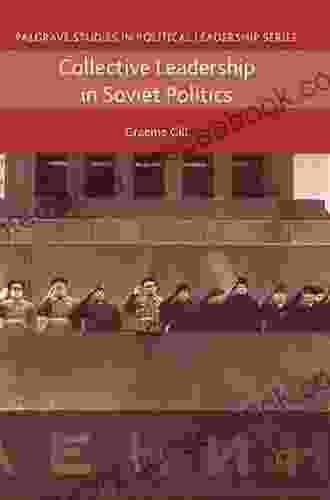Collective Leadership in Soviet Politics: Palgrave Studies in Political

5 out of 5
| Language | : | English |
| File size | : | 882 KB |
| Text-to-Speech | : | Enabled |
| Enhanced typesetting | : | Enabled |
| Word Wise | : | Enabled |
| Print length | : | 361 pages |
| Screen Reader | : | Supported |
The concept of collective leadership is central to understanding the political dynamics of the Soviet Union. From the aftermath of Stalin's death in 1953 until the collapse of the Soviet Union in 1991, the Soviet leadership was collectively exercised by the Politburo and the Central Committee of the Communist Party of the Soviet Union (CPSU).
This system of collective leadership was designed to prevent the emergence of another Stalinist dictatorship. It was based on the principle of "democratic centralism," which meant that decisions were made collectively by the leadership, but once a decision was made, it was binding on all members of the party.
In practice, however, collective leadership was often a complex and fluid process. The dynamics of the leadership changed over time, and the balance of power between different leaders varied depending on a number of factors, including their personal ambitions, their political skills, and the support they enjoyed from other members of the leadership.
The Early Years: Khrushchev and the "Thaw"
The period after Stalin's death was marked by a period of relative liberalization known as the "Thaw." This period was led by Nikita Khrushchev, who became First Secretary of the CPSU in 1953. Khrushchev denounced Stalin's crimes and initiated a number of reforms designed to improve the lives of Soviet citizens.
Khrushchev's reforms included the release of political prisoners, the expansion of social welfare programs, and the reduction of censorship. He also attempted to improve relations with the West, and he met with U.S. President Dwight D. Eisenhower at the Geneva Summit in 1955.
However, Khrushchev's reforms also met with resistance from conservative elements within the party leadership. In 1957, he was forced to resign as First Secretary after a failed attempt to remove his rivals from the Politburo.
The Brezhnev Era: Stability and Stagnation
Leonid Brezhnev became First Secretary of the CPSU in 1964. Brezhnev presided over a period of relative stability and economic growth. However, his leadership was also marked by a growing conservatism and a crackdown on dissent.
Brezhnev's foreign policy was characterized by a policy of "peaceful coexistence" with the West. However, he also increased Soviet military spending and intervened in Afghanistan in 1979.
Brezhnev's leadership was also marked by a growing corruption and inefficiency. By the late 1970s, the Soviet economy was in a state of decline, and the country was facing a number of social problems, including alcoholism, drug addiction, and crime.
Gorbachev and the End of the Soviet Union
Mikhail Gorbachev became General Secretary of the CPSU in 1985. Gorbachev was a young and energetic leader who was committed to reforming the Soviet system. He introduced a number of reforms, including glasnost (openness) and perestroika (restructuring).
Gorbachev's reforms led to a loosening of political controls and a greater degree of economic freedom. However, they also led to a number of unintended consequences, including ethnic unrest and economic instability.
In 1991, the Soviet Union collapsed. The collapse of the Soviet Union was due to a number of factors, including the failure of Gorbachev's reforms, the rising tide of nationalism in the Soviet republics, and the economic and political crisis that the Soviet Union was facing.
The concept of collective leadership was central to the political dynamics of the Soviet Union. It was a system that was designed to prevent the emergence of another Stalinist dictatorship, but it was also a system that was often complex and fluid.
The dynamics of collective leadership changed over time, and the balance of power between different leaders varied depending on a number of factors. In the early years, Khrushchev led a period of relative liberalization, but he was forced to resign after a failed attempt to remove his rivals from the Politburo.
Brezhnev presided over a period of relative stability and economic growth, but his leadership was also marked by a growing conservatism and a crackdown on dissent. In the late 1980s, Gorbachev introduced a number of reforms, but they led to a number of unintended consequences, including ethnic unrest and economic instability.
The collapse of the Soviet Union in 1991 was due to a number of factors, including the failure of Gorbachev's reforms, the rising tide of nationalism in the Soviet republics, and the economic and political crisis that the Soviet Union was facing.
5 out of 5
| Language | : | English |
| File size | : | 882 KB |
| Text-to-Speech | : | Enabled |
| Enhanced typesetting | : | Enabled |
| Word Wise | : | Enabled |
| Print length | : | 361 pages |
| Screen Reader | : | Supported |
Do you want to contribute by writing guest posts on this blog?
Please contact us and send us a resume of previous articles that you have written.
 Book
Book Novel
Novel Text
Text Genre
Genre Library
Library Magazine
Magazine Newspaper
Newspaper Sentence
Sentence Bookmark
Bookmark Synopsis
Synopsis Manuscript
Manuscript Codex
Codex Tome
Tome Bestseller
Bestseller Classics
Classics Library card
Library card Autobiography
Autobiography Encyclopedia
Encyclopedia Dictionary
Dictionary Thesaurus
Thesaurus Librarian
Librarian Catalog
Catalog Card Catalog
Card Catalog Borrowing
Borrowing Stacks
Stacks Archives
Archives Periodicals
Periodicals Lending
Lending Reserve
Reserve Journals
Journals Reading Room
Reading Room Special Collections
Special Collections Interlibrary
Interlibrary Literacy
Literacy Thesis
Thesis Dissertation
Dissertation Awards
Awards Reading List
Reading List Book Club
Book Club Textbooks
Textbooks A R Lowe
A R Lowe Jason Anspach
Jason Anspach Belloli Publishing
Belloli Publishing Diana Lemberg
Diana Lemberg Christine Lynn Herman
Christine Lynn Herman Chris Agos
Chris Agos Rosalind Kerven
Rosalind Kerven Mischa Titiev
Mischa Titiev William Lyon Phelps
William Lyon Phelps Roy Newsome
Roy Newsome B E Baker
B E Baker Isabel L Beck
Isabel L Beck Mary Salyers
Mary Salyers Javon Bates
Javon Bates Todd Huizinga
Todd Huizinga H D Walker
H D Walker Jeff Rubin
Jeff Rubin Kiersten Modglin
Kiersten Modglin Morgan Deane
Morgan Deane Emm Gryner
Emm Gryner
Light bulbAdvertise smarter! Our strategic ad space ensures maximum exposure. Reserve your spot today!

 Clarence MitchellAracoma Princess Oakley Dean Baldwin: A Native American Warrior and Educator
Clarence MitchellAracoma Princess Oakley Dean Baldwin: A Native American Warrior and Educator Ray BlairFollow ·2.6k
Ray BlairFollow ·2.6k Terry PratchettFollow ·14.5k
Terry PratchettFollow ·14.5k Eli BrooksFollow ·15.4k
Eli BrooksFollow ·15.4k Guillermo BlairFollow ·7.7k
Guillermo BlairFollow ·7.7k VoltaireFollow ·13.3k
VoltaireFollow ·13.3k Max TurnerFollow ·11.6k
Max TurnerFollow ·11.6k Shawn ReedFollow ·16.9k
Shawn ReedFollow ·16.9k Javier BellFollow ·7.9k
Javier BellFollow ·7.9k

 Bo Cox
Bo CoxDiscover the Enchanting Allure of Collingwood, Ontario,...
Nestled amidst the breathtaking landscape of...

 Ralph Ellison
Ralph EllisonThe Street of Clocks Poems: A Poetic Journey Through Time
Welcome to The Street...

 Dwight Blair
Dwight BlairCritical Political Economy of the Middle East and North...
The Middle East and...

 Deion Simmons
Deion SimmonsPerfect Strategies For Painting Amazing Marine Creatures...
Gouache is a...

 Hugh Bell
Hugh BellThe American Republic: Constitution, Tendencies, and...
The American Republic,...
5 out of 5
| Language | : | English |
| File size | : | 882 KB |
| Text-to-Speech | : | Enabled |
| Enhanced typesetting | : | Enabled |
| Word Wise | : | Enabled |
| Print length | : | 361 pages |
| Screen Reader | : | Supported |












